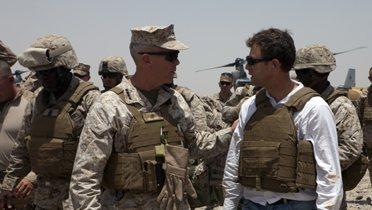In mid-May, I visited Afghanistan as part of a small team led by Marine Corps Commandant General James Amos. Our main focus was Helmand province, in the southern part of the country. That province is Afghanistan’s (and thus the world’s) traditional center of poppy cultivation, a major Taliban stronghold, a major Taliban thoroughfare for reaching Kandahar and nearby areas from Pakistan, and generally a troubled spot. But it is also now the province with the highest foreign troop density of any major area in the country—with some 20,000 Marines and almost 10,000 British forces and some other troops from Denmark, Georgia, and elsewhere. And it is showing considerable promise.
I wrote about part of what I learned on the trip in the Saturday May 21 issue of The New York Times, in an oped entitled “Finally, A Fighting Force.” Critics including the former Marine, Bing West, have been arguing that Afghans don’t fight and I was intrigued by the question. It is true that it has been hard to recruit enough Pashtuns from southern Afghan provinces to join the police and army during most of the last decade. And it is true that the police force in particular has often been corrupt. But I was encouraged by what I saw, heard, and otherwise learned on the trip. A number of reforms begun under General Stanley McChrystal have finally begun to pay off—not least because even after Afghan forces are recruited and trained, they continue to work with NATO troops in the field under a “sister unit” concept that amounts to a form of intensive apprenticeship.
There were other encouraging signs too. Southern Afghanistan has traditionally had even weaker civilian governance than the rest of the country but that is starting to change. Of all the provincial and district government positions in Helmand, 60 percent are now filled by Afghans, most of whom appear able and reasonably committed according to American and British troops and civilians who work with them—up from 30 percent just over a year ago. In an indication of improving security on the roads, these officials now travel about mostly by car rather than NATO helicopter, as was previously the case. Most indicators of quality of life and economic improvement are headed in the right direction, and poppy production though still sky high has been cut in half over the last three years.
Other encouraging signs abound too. Afghans are now providing tips to their own military and police as well as NATO soldiers at twice last year’s level. No major cities and only a few significant towns remain Taliban strongholds any longer. Believe it or not, some 10,000 Afghans attended a rock concert in the central town of Marja this spring. Things are looking up.
Of course tragedy continues. With the poppy harvest season wrapping up during our visit, NATO and Afghan officials were waiting with baited breath for the return of “fighting season,” the time in late May when the violence typically ticks up. Assassination attempts against key political figures can be expected. The Afghan Local Police, a sort of organized government-supervised community defense force, may be targeted by desperate Taliban fighters too. All fingers are crossed for the coming months, even as many are hopeful that Taliban sanctuaries have been so thoroughly challenged, and local Taliban leaders so decimated (meaning that the average age of commanders has dropped from 36 to 23 years old), that this year will go substantially better than the last couple. If that happens, and we keep building up the army and police and government structures, the future is promising.
None of this supplants the need for a better strategy of dealing with Kabul and Islamabad, of course. Corruption remains endemic and, as President Karzai starts to move slowly towards the end of his second term in 2014, there is no strong political process or system to help choose his successor. Ryan Crocker will have his work cut out for him as ambassador; so will many others. But the battlefield report, for perhaps the first time in my seven trips to Afghanistan, is finally encouraging.




